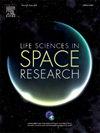The ocular surface during spaceflight: Post-mission symptom report, extraterrestrial risks, and in-flight therapeutics
IF 2.8
3区 生物学
Q2 ASTRONOMY & ASTROPHYSICS
引用次数: 0
Abstract
Ocular health is critical for overall astronaut health requirements given its essential role for mission performance and safety. The ocular surface is a vital structure to the visual system and is essential for ocular protection and the refraction of light for focused vision. Data from the 2024 NASA Lifetime Surveillance of Astronaut Health identified that Space Shuttle and International Space Station (ISS) astronauts (N = 257) queried during post-flight eye exams reported symptoms of eye irritation (34 %), dry eyes (14 %), and foreign body sensation (21 %). Given these findings, it is critical to understand the risks that the ocular surface faces in the spaceflight environment. This manuscript explores the impact of lunar dust, space radiation, lunar gravity, and microgravity on the astronaut ocular surface. Furthermore, we outline ongoing efforts to minimize associated health risks given our insights into the vision standards, testing procedures, corrective measures, and mitigations designed for the lunar surface and microgravity environments. We further discuss the ophthalmic medications available on space missions to address threats to the ocular surface. We also report personal insights from Dr. Harrison Schmitt, NASA astronaut and Apollo 17 moonwalker, on his experience in space and lunar dust human physiological interactions. Additionally, given the known physiologic changes in microgravity and expectations for partial gravity environments, our review prompted characterization of accelerated aging and gut microbiome on the development of dry eye. We also discuss the potential expansion of ophthalmic imaging capabilities during spaceflight missions and its utility. Addressing these factors is critical to uphold astronauts' ocular health and to ensure the safety of future space missions.
太空飞行中的眼表:任务后症状报告、地外风险和飞行治疗
鉴于眼健康对任务性能和安全的重要作用,它对宇航员的整体健康要求至关重要。眼表是视觉系统的重要结构,对眼部保护和聚焦视力的光折射至关重要。来自2024年NASA宇航员健康终身监测的数据表明,航天飞机和国际空间站(ISS)的宇航员(N = 257)在飞行后的眼部检查中被询问,报告了眼睛刺激(34%)、眼睛干涩(14%)和异体感(21%)的症状。鉴于这些发现,了解眼表在航天环境中面临的风险是至关重要的。本文探讨了月球尘埃、空间辐射、月球重力和微重力对宇航员眼表的影响。此外,鉴于我们对针对月球表面和微重力环境设计的视力标准、测试程序、纠正措施和缓解措施的见解,我们概述了为尽量减少相关健康风险而正在进行的努力。我们进一步讨论了太空任务中可用的眼科药物,以解决对眼表的威胁。我们还报道了Harrison Schmitt博士的个人见解,他是美国宇航局宇航员和阿波罗17号月球漫步者,关于他在太空和月球尘埃中人类生理相互作用的经验。此外,考虑到微重力环境下已知的生理变化和对部分重力环境的预期,我们的研究提示了干眼症发展中加速衰老和肠道微生物组的特征。我们还讨论了在航天飞行任务中眼科成像能力的潜在扩展及其效用。解决这些因素对于维护宇航员的眼健康和确保未来太空任务的安全至关重要。
本文章由计算机程序翻译,如有差异,请以英文原文为准。
求助全文
约1分钟内获得全文
求助全文
来源期刊

Life Sciences in Space Research
Agricultural and Biological Sciences-Agricultural and Biological Sciences (miscellaneous)
CiteScore
5.30
自引率
8.00%
发文量
69
期刊介绍:
Life Sciences in Space Research publishes high quality original research and review articles in areas previously covered by the Life Sciences section of COSPAR''s other society journal Advances in Space Research.
Life Sciences in Space Research features an editorial team of top scientists in the space radiation field and guarantees a fast turnaround time from submission to editorial decision.
 求助内容:
求助内容: 应助结果提醒方式:
应助结果提醒方式:


